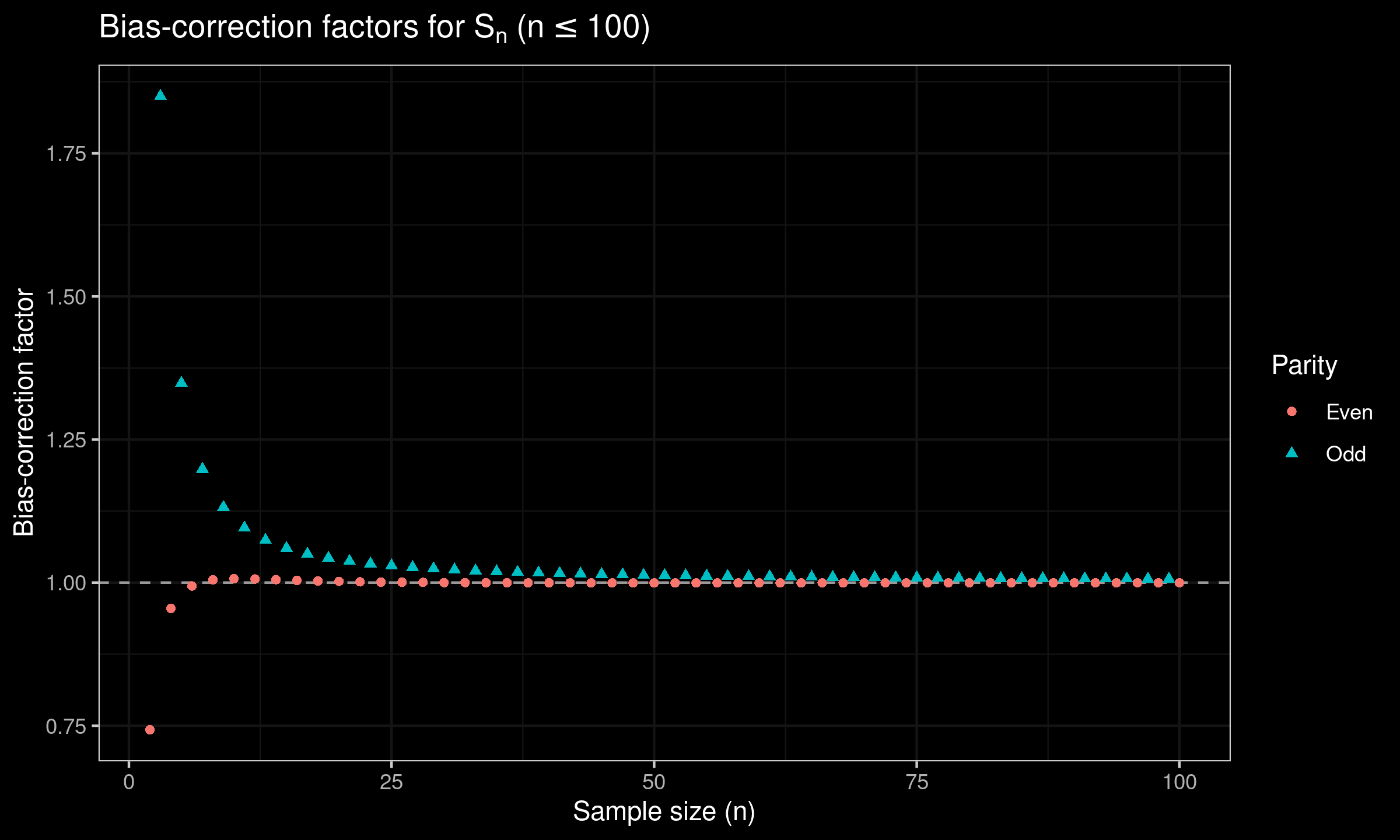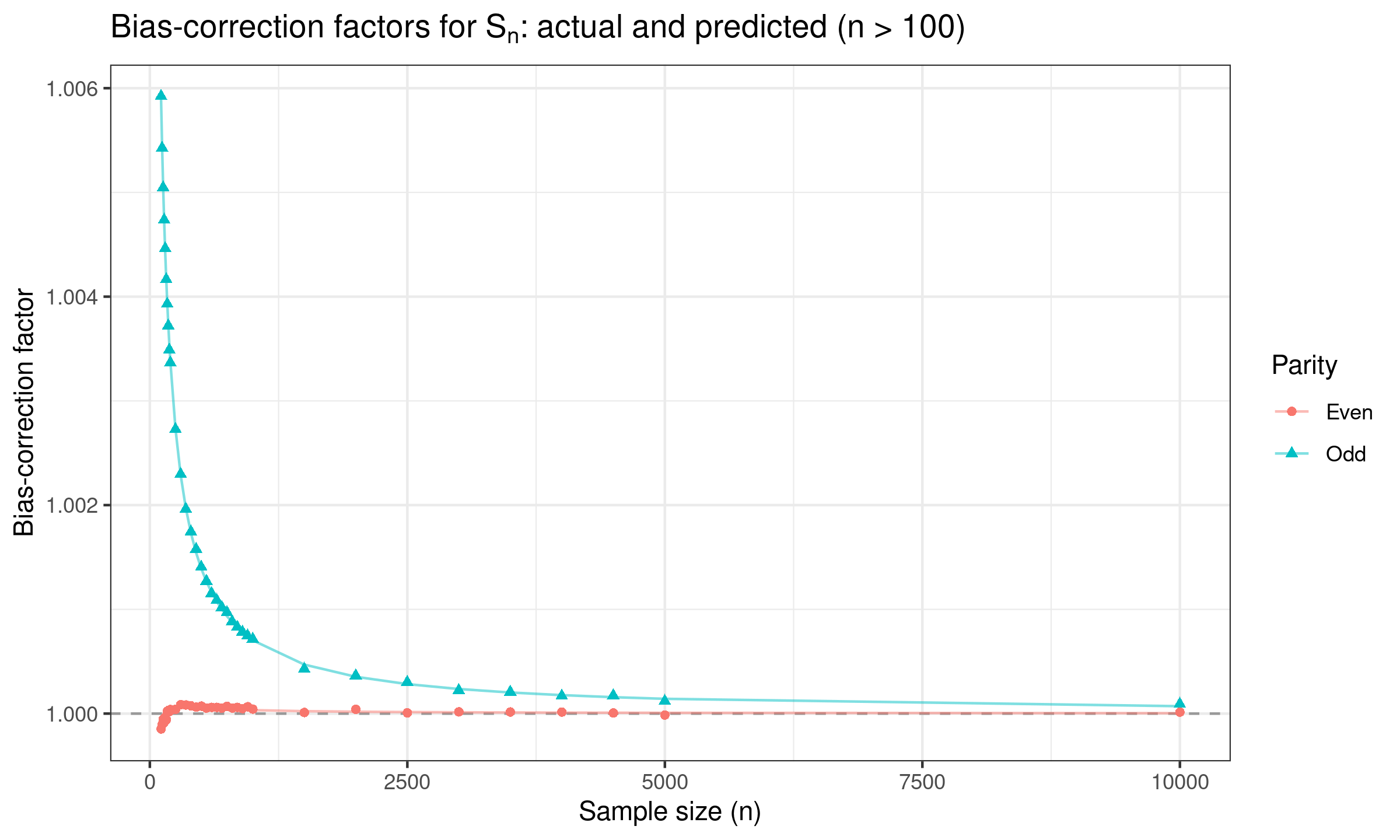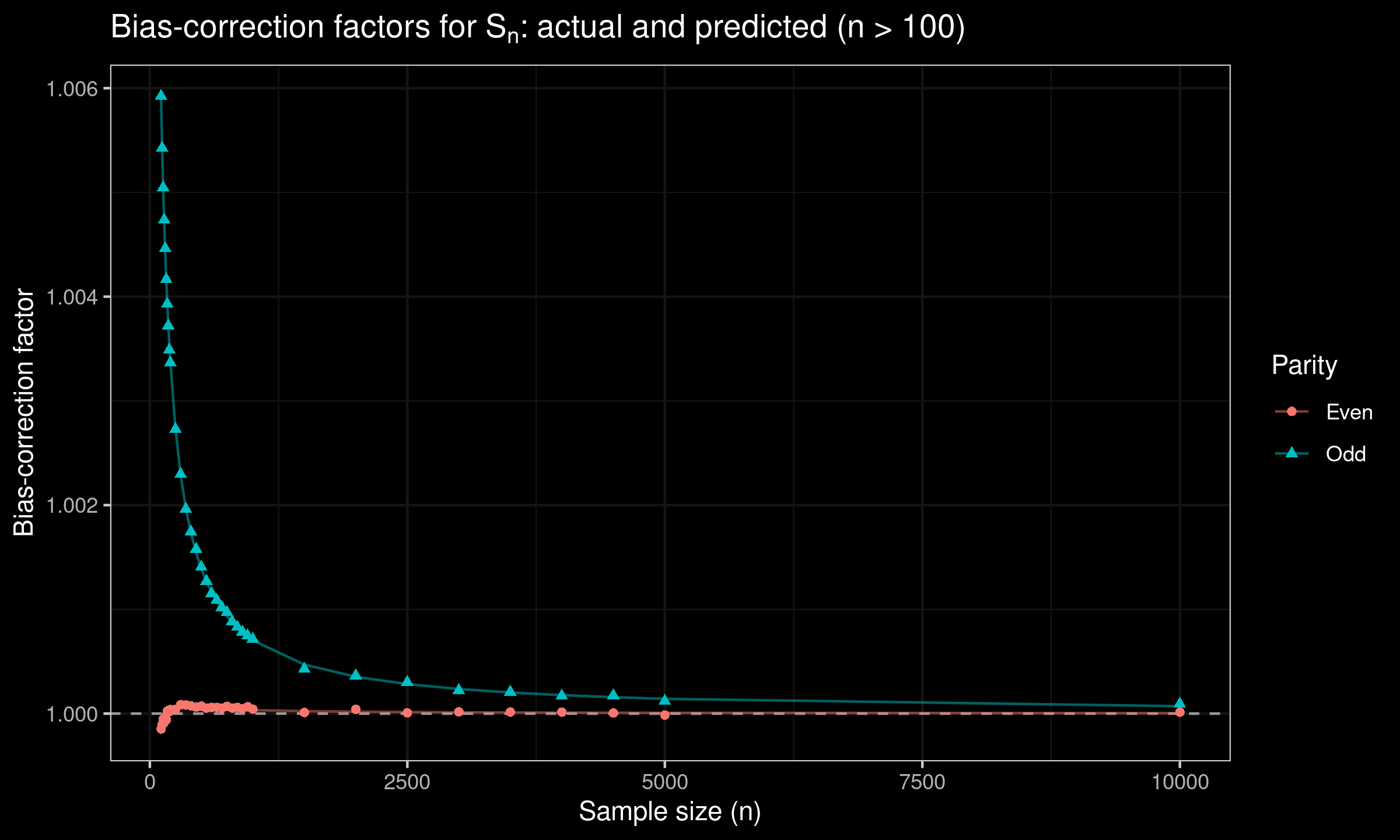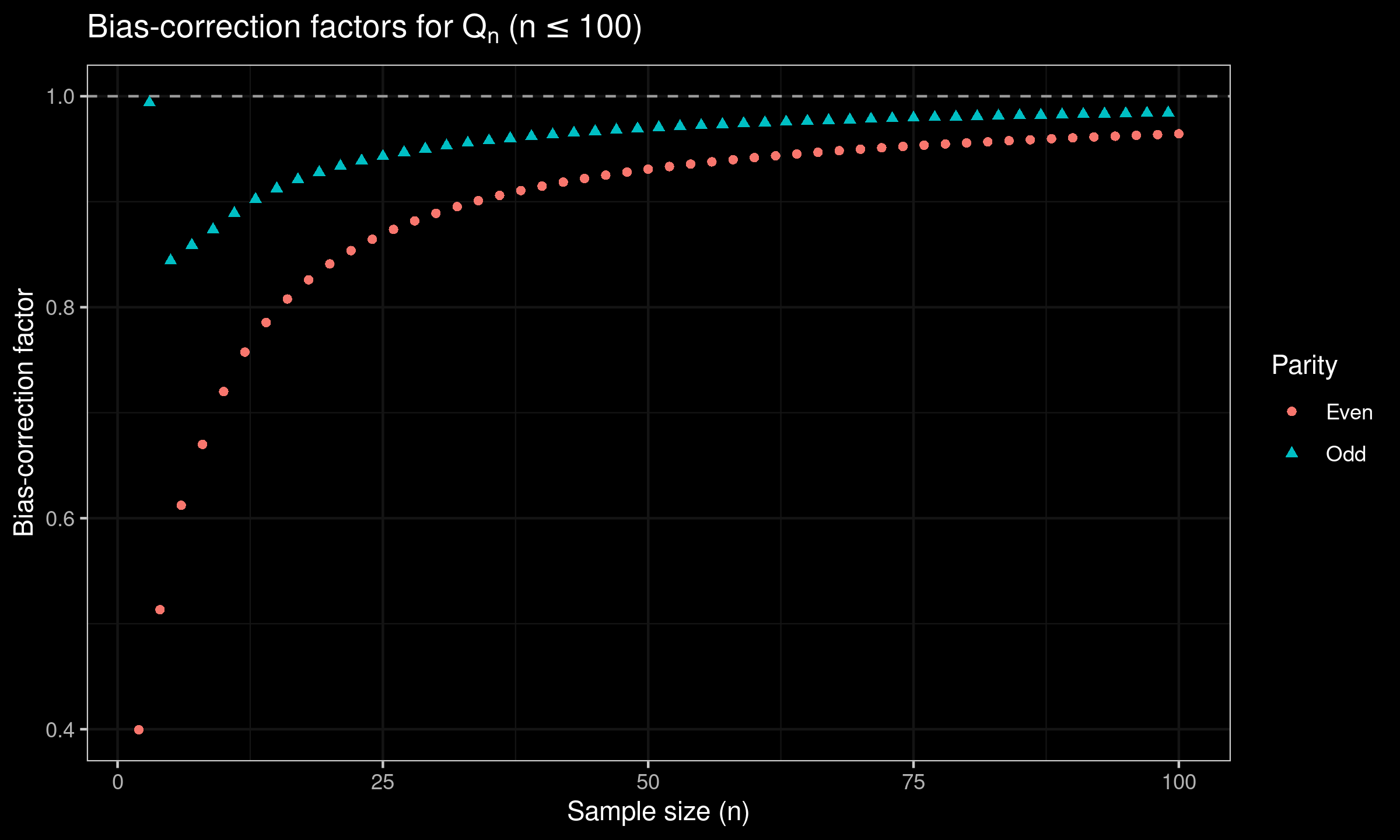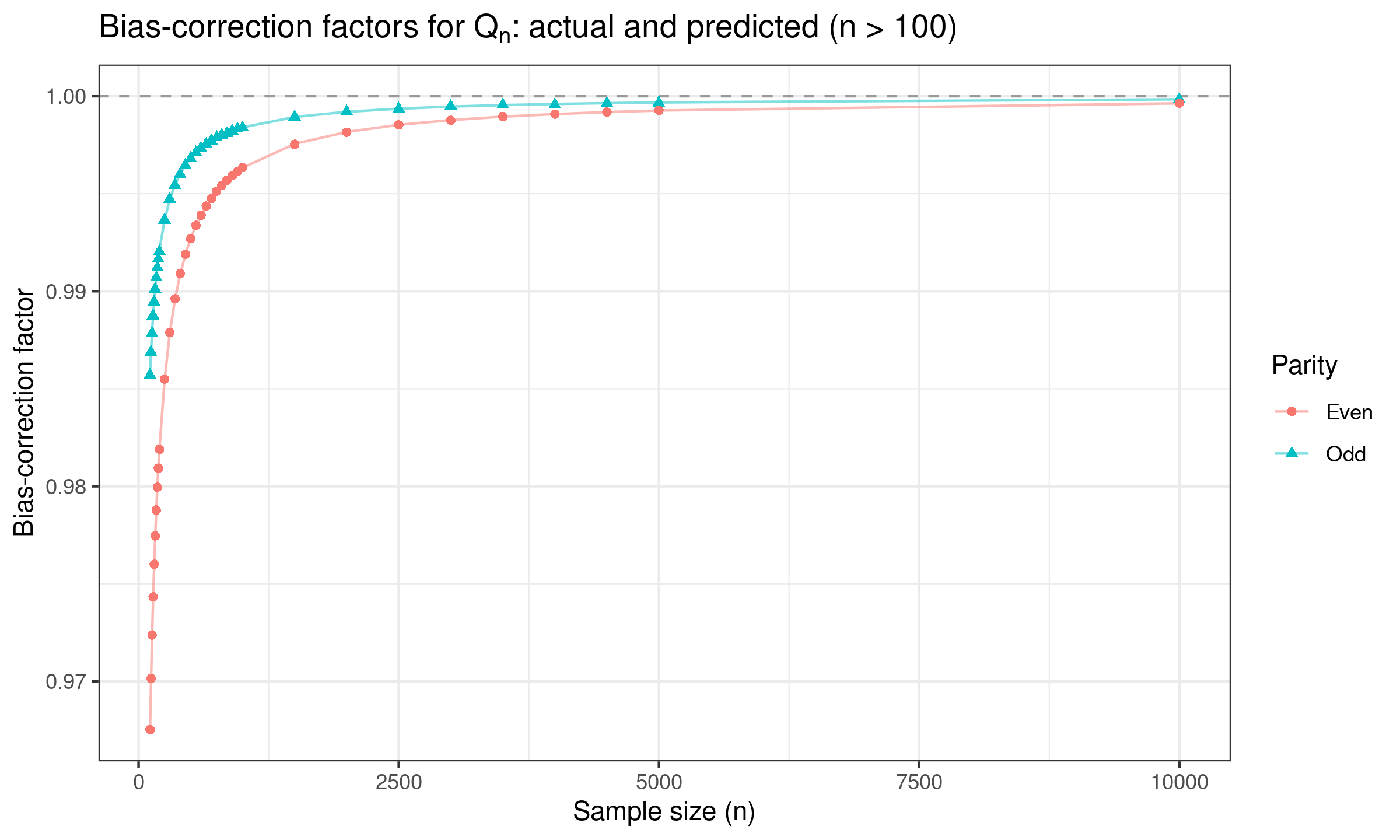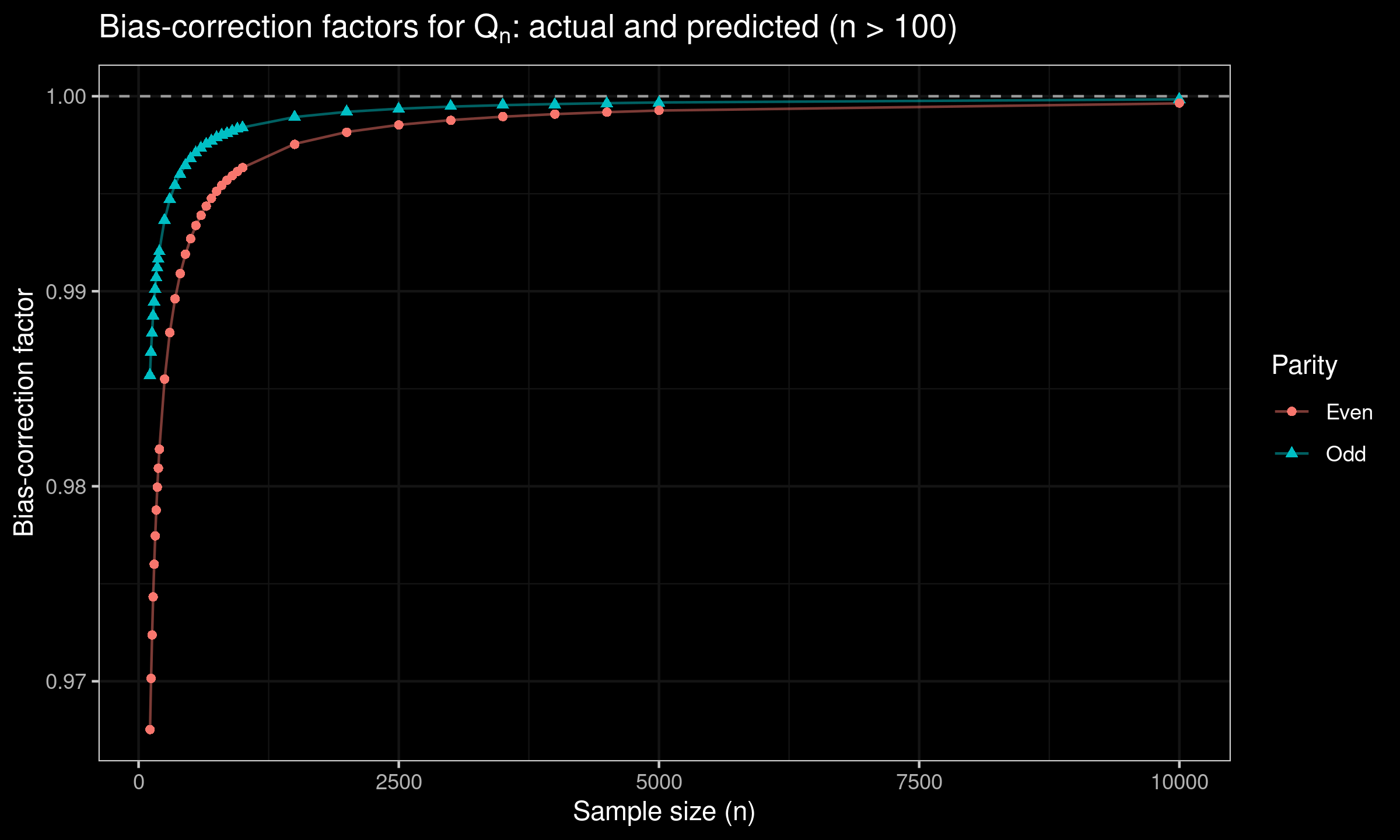Finite-sample bias correction factors for Rousseeuw-Croux scale estimators
The Rousseeuw-Croux scale estimators $S_n$ and $Q_n$ are efficient alternatives to the median absolute deviation ($\operatorname{MAD}_n$). While all three estimators have the same breakdown point of $50\%$, $S_n$ and $Q_n$ have higher statistical efficiency than $\operatorname{MAD}_n$. The asymptotic Gaussian efficiency values of $\operatorname{MAD}_n$, $S_n$, and $Q_n$ are $37\%$, $58\%$, and $82\%$ respectively.
Using scale constants, we can make $S_n$ and $Q_n$ consistent estimators for the standard deviation under normality. The asymptotic values of these constants are well-known. However, for finite-samples, only approximated scale constants are known. In this post, we provide refined values of these constants with higher accuracy.
Introduction
The $S_n$ and $Q_n$ estimators are presented in Alternatives to the Median Absolute Deviation
By Peter J Rousseeuw, Christophe Croux
·
1993rousseeuw1993.
For a sample $x = \{ x_1, x_2, \ldots, x_n \}$, they are defined as follows:
where
- $\operatorname{lowmed}$ is the $\lfloor (n+1) / 2 \rfloor^\textrm{th}$ order statistic out of $n$ numbers,
- $\operatorname{highmed}$ is the $(\lfloor n / 2 \rfloor + 1)^\textrm{th}$ order statistic out of $n$ numbers,
- $c_n$, $d_n$ are bias-correction factors for finite samples (some approximation can be found in [Rousseeuw1993]),
- $k = \binom{\lfloor n / 2 \rfloor + 1}{2}$,
- ${}_{(k)}$ is the $k^\textrm{th}$ order statistic.
In Time-Efficient Algorithms for Two Highly Robust Estimators of Scale
By Christophe Croux, Peter J Rousseeuw, Yadolah Dodge, Joe Whittaker
·
1992croux1992), rough approximations of $c_n$ and $d_n$ are given.
The values for $n \leq 9$ are presented in the following table:
| n | $c_n$ | $d_n$ |
|---|---|---|
| 2 | 0.743 | 0.399 |
| 3 | 1.851 | 0.994 |
| 4 | 0.954 | 0.512 |
| 5 | 1.351 | 0.844 |
| 6 | 0.993 | 0.611 |
| 7 | 1.198 | 0.857 |
| 8 | 1.005 | 0.669 |
| 9 | 1.131 | 0.872 |
For $n \geq 10$, they suggested using the following prediction equations:
$$ c_n = \frac{n}{n - 0.9}, \quad \textrm{for odd}\; n, $$$$ c_n = 1, \quad \textrm{for even}\; n, $$$$ d_n = \frac{n}{n + 1.4}, \quad \textrm{for odd}\; n, $$$$ d_n = \frac{n}{n + 3.8}, \quad \textrm{for even}\; n. $$In the R package robustbase, adjusted values of $d_n$ are used:
| n | $d_n$ |
|---|---|
| 2 | 0.399356 |
| 3 | 0.99365 |
| 4 | 0.51321 |
| 5 | 0.84401 |
| 6 | 0.61220 |
| 7 | 0.85877 |
| 8 | 0.66993 |
| 9 | 0.87344 |
| 10 | 0.72014 |
| 11 | 0.88906 |
| 12 | 0.75743 |
For $n > 12$, the following prediction equations are used:
$$ d_n = \big( 1 + 1.60188 n^{-1} - 2.1284 n^{-2} - 5.172 n^{-3} \big)^{-1}, \quad \textrm{for odd}\; n, $$$$ d_n = \big( 1 + 3.67561 n^{-1} + 1.9654 n^{-2} + 6.987 n^{-3} - 77 n^{-4} \big)^{-1}, \quad \textrm{for even}\; n. $$Refined bias-correction factors
In order to obtain refined values of the bias-correction factors, we perform an extensive Monte-Carlo simulations. Here are the raw results for $n \leq 100$:
| n | $c_n$ | $d_n$ |
|---|---|---|
| 2 | 0.74303 | 0.39954 |
| 3 | 1.84983 | 0.99386 |
| 4 | 0.95505 | 0.51333 |
| 5 | 1.34857 | 0.84412 |
| 6 | 0.99413 | 0.61224 |
| 7 | 1.19832 | 0.85886 |
| 8 | 1.00496 | 0.67000 |
| 9 | 1.13178 | 0.87359 |
| 10 | 1.00689 | 0.72007 |
| 11 | 1.09592 | 0.88902 |
| 12 | 1.00635 | 0.75748 |
| 13 | 1.07423 | 0.90232 |
| 14 | 1.00513 | 0.78551 |
| 15 | 1.06006 | 0.91248 |
| 16 | 1.00384 | 0.80779 |
| 17 | 1.05006 | 0.92106 |
| 18 | 1.00281 | 0.82600 |
| 19 | 1.04297 | 0.92793 |
| 20 | 1.00219 | 0.84105 |
| 21 | 1.03738 | 0.93380 |
| 22 | 1.00139 | 0.85367 |
| 23 | 1.03311 | 0.93894 |
| 24 | 1.00091 | 0.86441 |
| 25 | 1.02969 | 0.94303 |
| 26 | 1.00066 | 0.87372 |
| 27 | 1.02686 | 0.94680 |
| 28 | 1.00045 | 0.88186 |
| 29 | 1.02449 | 0.95009 |
| 30 | 1.00005 | 0.88901 |
| 31 | 1.02260 | 0.95304 |
| 32 | 0.99995 | 0.89531 |
| 33 | 1.02087 | 0.95566 |
| 34 | 0.99974 | 0.90099 |
| 35 | 1.01950 | 0.95789 |
| 36 | 0.99978 | 0.90600 |
| 37 | 1.01830 | 0.96004 |
| 38 | 0.99960 | 0.91061 |
| 39 | 1.01717 | 0.96192 |
| 40 | 0.99969 | 0.91480 |
| 41 | 1.01619 | 0.96361 |
| 42 | 0.99960 | 0.91852 |
| 43 | 1.01538 | 0.96522 |
| 44 | 0.99955 | 0.92200 |
| 45 | 1.01460 | 0.96668 |
| 46 | 0.99960 | 0.92515 |
| 47 | 1.01391 | 0.96802 |
| 48 | 0.99948 | 0.92809 |
| 49 | 1.01324 | 0.96923 |
| 50 | 0.99953 | 0.93085 |
| 51 | 1.01264 | 0.97040 |
| 52 | 0.99954 | 0.93334 |
| 53 | 1.01228 | 0.97147 |
| 54 | 0.99949 | 0.93566 |
| 55 | 1.01175 | 0.97237 |
| 56 | 0.99950 | 0.93781 |
| 57 | 1.01127 | 0.97328 |
| 58 | 0.99955 | 0.93985 |
| 59 | 1.01090 | 0.97421 |
| 60 | 0.99959 | 0.94180 |
| 61 | 1.01054 | 0.97496 |
| 62 | 0.99954 | 0.94355 |
| 63 | 1.01023 | 0.97573 |
| 64 | 0.99963 | 0.94525 |
| 65 | 1.00988 | 0.97648 |
| 66 | 0.99968 | 0.94687 |
| 67 | 1.00951 | 0.97710 |
| 68 | 0.99959 | 0.94837 |
| 69 | 1.00923 | 0.97773 |
| 70 | 0.99966 | 0.94978 |
| 71 | 1.00902 | 0.97837 |
| 72 | 0.99965 | 0.95112 |
| 73 | 1.00877 | 0.97891 |
| 74 | 0.99964 | 0.95235 |
| 75 | 1.00851 | 0.97944 |
| 76 | 0.99966 | 0.95359 |
| 77 | 1.00835 | 0.97999 |
| 78 | 0.99968 | 0.95472 |
| 79 | 1.00810 | 0.98049 |
| 80 | 0.99966 | 0.95579 |
| 81 | 1.00790 | 0.98090 |
| 82 | 0.99970 | 0.95677 |
| 83 | 1.00765 | 0.98138 |
| 84 | 0.99970 | 0.95781 |
| 85 | 1.00762 | 0.98179 |
| 86 | 0.99968 | 0.95871 |
| 87 | 1.00740 | 0.98216 |
| 88 | 0.99972 | 0.95967 |
| 89 | 1.00723 | 0.98255 |
| 90 | 0.99973 | 0.96051 |
| 91 | 1.00705 | 0.98295 |
| 92 | 0.99974 | 0.96139 |
| 93 | 1.00689 | 0.98329 |
| 94 | 0.99974 | 0.96212 |
| 95 | 1.00674 | 0.98363 |
| 96 | 0.99978 | 0.96294 |
| 97 | 1.00661 | 0.98399 |
| 98 | 0.99973 | 0.96364 |
| 99 | 1.00650 | 0.98430 |
| 100 | 0.99982 | 0.96438 |
For $n > 100$, we suggest using the following prediction equations:
$$ c_n = 1 + 0.7096 n^{-1} - 7.3604 n^{-2}, \quad \textrm{for odd}\; n, $$$$ c_n = 1 + 0.0391 n^{-1} - 6.1719 n^{-2}, \quad \textrm{for even}\; n, $$$$ d_n = 1 - 1.6022 n^{-1} + 4.7453 n^{-2}, \quad \textrm{for odd}\; n, $$$$ d_n = 1 -3.6741 n^{-1} + 11.1030 n^{-2}, \quad \textrm{for even}\; n. $$Here are the corresponding plots:
References
- [Croux1992]
Croux, Christophe, and Peter J. Rousseeuw. “Time-Efficient Algorithms for Two Highly Robust Estimators of Scale.” In Computational Statistics, edited by Yadolah Dodge and Joe Whittaker, 411–28. Heidelberg: Physica-Verlag HD, 1992.
https://doi.org/10.1007/978-3-662-26811-7_58. - [Rousseeuw1993]
Rousseeuw, Peter J., and Christophe Croux. “Alternatives to the Median Absolute Deviation.” Journal of the American Statistical Association 88, no. 424 (December 1, 1993): 1273–83.
https://doi.org/10.1080/01621459.1993.10476408.

